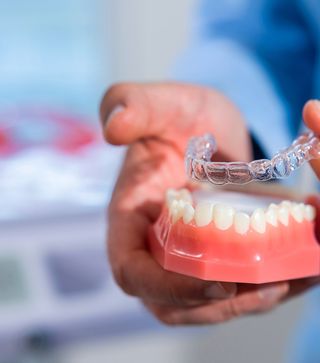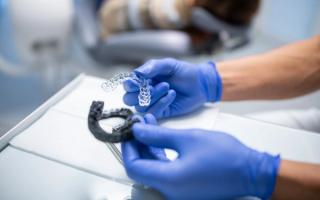Invisalign vs Braces: Pros and Cons

If your dentist has recommended orthodontic treatment, the major decision is whether to get Invisalign or braces.
Your first step in making that decision will be to learn more about what both braces and Invisalign entail, so you can decide which is better for you and your oral health.
What are clear aligners?
Invisalign is marketed as the clear alternative to braces, but that is a very basic description of what it is.

Invisalign is an orthodontic treatment that offers the same results as traditional braces - straight, aligned teeth - but with a different approach. Invisalign uses a series of custom-made aligners (also known as retainers) that slowly move your teeth into place.
You must wear these aligners for at least 22 hours per day, but you can take them out for short periods of time to eat, drink, brush your teeth, and even smile for the camera.
However, even when you are wearing the aligners, they are barely noticeable. They are clear and slip tightly over your teeth, so they often go unnoticed during wear.
Patients will typically wear Invisalign retainers for 6 to 18 months, but the time of treatment varies from person to person depending on their oral health and dental goals.
What are dental braces?
Dental braces are the traditional form of orthodontic treatment. Traditional braces are often referred to as metal braces and are a common option using stainless steel brackets and wires.

They work by attaching a small metal bracket to the front of each of your teeth, then threading a special wire through each bracket. This wire then pulls your teeth into line as it straightens out.
Braces can improve your dental health by straightening teeth, closing gaps, correcting bites, and more.
Braces are noticeable when you speak and smile, and once they are on, you cannot take them off until treatment is complete.
Most patients will wear dental braces for 12 to 18 months, although this timeline varies from one person to the next.
What are the main differences between Invisalign vs braces?
There are several major differences between Invisalign and braces that may help you decide which option is best for you.
Appearance
The appearance of Invisalign and braces is quite different. Notably, Invisalign is barely noticeable - someone would have to be standing quite close and looking at your teeth to see that you’re wearing them. While braces are common and accepted, they are usually noticeable right away when you speak or smile.
Comfort
The experience of wearing Invisalign and braces can be quite different. As braces require metal brackets on your teeth, you are definitely aware of them, and they can occasionally cause ulcers when they rub up against your cheeks. Invisalign is a more comfortable experience as the aligners slip over your teeth, so they don’t tend to cause any issues.
Permanence
Patients typically wear Invisalign and braces for a similar amount of time, however, during that time you cannot remove the braces for eating, drinking, cleaning or photos. Braces are on 24/7, but you can take Invisalign out for up to two hours per day.
Cost
Another factor to consider is the cost. Invisalign is generally more costly than braces, so you may need to take your budget into account when making your decision.
How effective is Invisalign?
Invisalign is a highly effective treatment for a variety of orthodontic issues, including mild-to-severe tooth crowding, overbite, underbite, and gaps between teeth.
One of the standout features of Invisalign is its ability to offer precise control over tooth movement, thanks to its custom-made clear aligners. Studies have shown that Invisalign has a success rate of around 90% for treating mild to moderate orthodontic cases.
This makes it a reliable option for many patients looking to improve their smile discreetly.
How effective are braces?
When it comes to tackling more complex orthodontic issues, traditional braces are incredibly effective. Braces can address a wide range of problems, including severe crowding, significant bite issues, and other challenging cases that might be beyond the scope of Invisalign.
According to the American Association of Orthodontists (AAO), braces boast a success rate of around 95% in treating various orthodontic conditions. This high success rate makes braces a trusted choice for those needing comprehensive dental correction.
Success comparison
Both Invisalign and braces have impressive success rates, but their effectiveness can vary depending on the complexity of the case.
Braces tend to be more effective for severe and complex orthodontic issues, while Invisalign is a popular choice for those seeking a more discreet and removable option.
Ultimately, the decision between Invisalign and braces should be based on the specific needs of the patient and the recommendations of their dentist.
Impact on daily life
One of the major conveniences of Invisalign is that the aligners are removable. This means you can easily take them out when eating, drinking, or cleaning your teeth, making it simpler to maintain good oral hygiene. However, to be effective, Invisalign trays must be worn for at least 20-22 hours per day. On the other hand, braces are fixed to your teeth and cannot be removed until the end of the treatment. This can make brushing and flossing more challenging and may require more frequent visits to the dentist for adjustments. It is crucial to maintain good oral hygiene practices to prevent issues such as tooth decay, especially when using traditional braces.
In terms of lifestyle, many adults and teens prefer Invisalign because it is less noticeable and can be removed for special occasions. Braces, while more visible, are often chosen for their affordability and effectiveness in treating complex cases. Both options require regular dentist visits to monitor progress, but Invisalign may necessitate fewer appointments compared to braces.
Is Invisalign better than braces?
The ultimate question is: Which is better?
And the answer comes down to you.
Many patients choose Invisalign for its many benefits. As well as straightening teeth and ensuring greater oral health, Invisalign is less noticeable, more comfortable, and easier in terms of day-to-day living due to being removable.
Yet braces are still a hugely popular option. As well as straightening teeth and improving dental health, braces are more affordable, common enough that no one thinks twice about them, and easy to get used to.
Ultimately, the decision is up to you, and your dentist can help you to weigh up the pros and cons of each and determine whether Invisalign or dental braces are best for your needs. Dental professionals offer a variety of high-quality dental services to address specific dental problems and enhance overall oral health and patient confidence.
Find out whether Invisalign or braces is better for you
If you’re unsure whether you’d prefer Invisalign or braces, or need to speak to a professional, get in touch with a dental professional that can help.
Our dental and orthodontic experts can guide you through the process and talk to you further about what your specific treatment plan might look like with each option.

